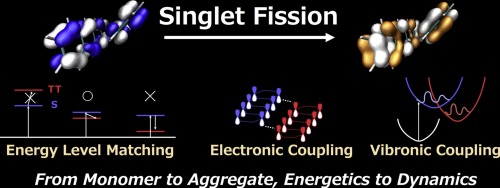Journal of Photochemistry and Photobiology C: Photochemistry Reviews ( IF 12.8 ) Pub Date : 2018-01-31 , DOI: 10.1016/j.jphotochemrev.2018.01.002 Soichi Ito , Takanori Nagami , Masayoshi Nakano

|
Singlet fission is a photophysical process in molecules and molecular aggregates, in which a singlet exciton generated by irradiation splits into two triplet excitons. Recently, singlet fission has attracted a great deal of attention from the viewpoint of applications in organic photovoltaic cells, where singlet fission has a possibility of improving the photoelectric conversion efficiency. Although singlet fission was first observed about 50 years ago in anthracene crystals, and the mechanism has been investigated in detail for a small number of molecular systems such as tetracene and pentacene crystals, the relationships between molecular or crystal structures and singlet fission efficiency are yet to be precisely clarified. Thus, molecular structure – singlet fission relationships and molecular or crystal design guidelines for efficient singlet fission are intensely desired for realizing efficient photovoltaic energy conversion, and experimental and theoretical investigations advance rapidly. We introduce three investigation steps, which are based on bottom-up theoretical modeling from a molecule to a molecular aggregate or crystal. The modelling involves energy level matching at the molecular level, electronic coupling at the aggregate level, and singlet fission dynamics including exciton–phonon (vibronic) coupling, by emphasizing the importance of interplay between each step. From the modelling, we present several design guidelines for efficient singlet fission, which is together with practical molecular structures, chemical modifications and molecular configurations.
中文翻译:

高效单线裂变的分子设计
单线态裂变是分子和分子聚集体中的光物理过程,其中通过辐射产生的单线态激子分裂为两个三线态激子。最近,从有机单电池裂变具有提高光电转换效率的可能性的有机光伏电池的应用的观点出发,单线裂变引起了极大的关注。尽管大约在50年前在蒽晶体中首次发现了单峰裂变,并且已经对少量分子系统(如并四苯和并五苯晶体)进行了详细的机理研究,但分子或晶体结构与单峰裂变效率之间的关系尚未阐明。明确说明。因此,分子结构–单线态裂变关系以及有效的单线态裂变的分子或晶体设计指南,对于实现高效的光伏能量转换非常迫切,并且实验和理论研究也在迅速发展。我们介绍了三个研究步骤,这些步骤基于从分子到分子聚集体或晶体的自下而上的理论建模。通过强调每个步骤之间相互作用的重要性,建模涉及分子水平的能量水平匹配,聚集水平的电子耦合以及包括激子-声子(振动)耦合在内的单线裂变动力学。通过建模,我们提出了有效的单线态裂变的几种设计指南,以及实用的分子结构,化学修饰和分子构型。









































 京公网安备 11010802027423号
京公网安备 11010802027423号